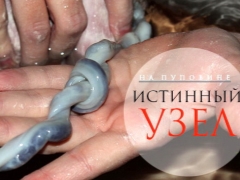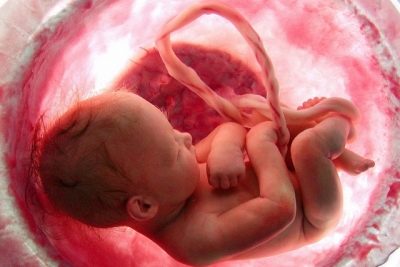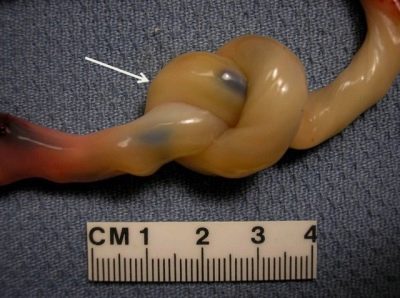What is a true umbilical cord knot and how is it dangerous for a child?
Among the various pathologies associated with the presence of defects in the umbilical cord, there are also quite dangerous. A true umbilical cord node is one such insidious pathology. This article will tell you what a true umbilical cord is and how dangerous it is for a child.
What does this mean?
Normally, the umbilical cord or umbilical cord is an elongated "cord". It stretches from baby to placenta. The umbilical cord can be considered a kind of “bridge” that connects an actively developing baby with his mother during pregnancy.
The umbilical cord is quite long. In a normal pregnancy, the length of a healthy umbilical cord is 50-70 cm. The thickness of the umbilical cord is usually about 2 cm. Such a rather large length makes the umbilical cord twist into loops or even knots. Doctors call such nodules true.
It should be noted that This pathology is quite rare in obstetric practice. If you focus on statistics, it can be noted that true nodes on the umbilical cord appear in about 1% of all cases. However, this pathological condition is extremely dangerous. It can significantly aggravate the course of pregnancy and even contribute to the development of dangerous pathologies in the fetus.
Reasons for education
A variety of factors can lead to the appearance of nodules on the umbilical cord. The most frequent reason for the development of this pathology is the intense physical activity of the baby. Usually the fetus that develops in the womb is more mobile in the first half of pregnancy. The smaller the size of the child, the easier it is for him to move.
As the baby grows, the number of active movements it starts to gradually decrease. This is because the baby gradually becomes crowded in the uterus. Such a feature determines the fact that true nodules on the umbilical cord are formed mainly up to 3 trimester of pregnancy. This fact is confirmed by the reviews of moms who faced this problem while carrying babies.
Diagnostics
Immediately it should be noted that the definition of true nodules on the umbilical cord - a rather difficult task. Usually, such changes are detected by doctors already retrospectively - after the birth of a child. After the birth of the afterbirth and umbilical cord, doctors can examine them carefully. With this inspection, as a rule, true nodules are detected.
Unfortunately, it is impossible to suspect the presence of pathology only for some clinical signs or symptoms. There are no specific signs that would absolutely accurately indicate the presence of nodules on the umbilical cord, no.
It should be noted that sometimes the umbilical cord nodules are still found during ultrasound. Usually this becomes possible when the research is conducted on the devices of the expert level, by an experienced and qualified specialist. The difficulty of finding true nodules on the umbilical cord is that the umbilical cord is quite long. Examination ultrasound specialist is not always able to examine every inch of him.
One can suspect the presence of a node on the umbilical cord through dopplerography. This method allows to evaluate the blood flow in the umbilical vessels.A decrease in the rate of blood flow in certain parts of the umbilical cord is one of the signs that may indicate the presence of a node.
If, during pregnancy, the nodes of the umbilical cord were found in the future mom during an ultrasound, then in the future she will be carefully monitored. In the time remaining before delivery, the doctor will necessarily assess the condition of the fetus. For this, cardiotocography is often used. Through this diagnostic test, you can determine the heart rate of a baby, as well as assess its motor activity.
Monitoring the activity of the baby can be carried out by the expectant mother herself. In the second half of pregnancy, she, as a rule, already feels a baby quite well in her stomach.
If a pregnant woman notes that her child has drastically changed his physical activity, then she should definitely warn his obstetrician-gynecologist about this.
Implications for the child
Imagine the full development of the baby without the umbilical cord is impossible. With the help of this unique organ, which appears in the female body only during pregnancy, the fetus receives all the nutrients necessary for its growth. A baby in the womb cannot eat on its own. He receives all the necessary proteins, fats and carbohydrates through the blood from his mother. Nutrients come through the blood vessels that are located directly inside the umbilical cord.
Through umbilical cord blood, the baby receives dissolved oxygen in the blood. During the prenatal life of the child's lungs do not function. The respiratory system will fully work only after the baby is born and makes its first breath in life. Up to this point, the baby receives dissolved oxygen through the system of umbilical cord vessels - from its mother.
The umbilical cord plays another important role: it is involved in the utilization of metabolites. Through the system of umbilical vessels, the fetus "gets rid of" the waste chemicals that are not necessary for its organism. Ensuring the functions of the umbilical cord is possible if during pregnancy there are no abnormalities or defects in the umbilical cord. The presence of nodes contributes to the fact that the blood vessels in the umbilical cord, pinch. In this case, the blood supply to the child and the placenta is impaired.
Lack of oxygen in the blood contributes to the fact that the baby develops an extremely dangerous condition - intrauterine hypoxia. It is dangerous because the blood supply to the internal organs of the child is greatly reduced. This leads to disruption of their functioning.
Persistent intrauterine hypoxia is also dangerous due to the fact that the baby may develop a disturbance of the heart activity. This situation is extremely dangerous and requires urgent intervention by doctors to preserve the life of the fetus.
In some cases, to determine the effects of prolonged intrauterine hypoxia in a baby is possible only after birth. Children who have experienced this pathology during their prenatal development may have less weight at birth, low immunity, as well as a number of concomitant congenital diseases. In some cases, persistent intrauterine hypoxia can contribute to the formation of a number of pathologies of the nervous system.
Thrombosis of the umbilical cord is another possible complication that can develop if there are true nodes on the umbilical cord. In the clamped section of the umbilical cord, blood flow is significantly reduced. Slowing blood flow contributes to the fact that the blood platelets (platelets) begin to stick together faster with each other, leading to the formation of blood clots.
By thrombosed umbilical cord is not possible full blood flow. In such a situation, the children's body does not receive enough nutrients and oxygen. The stronger the lumen of the umbilical cord blood vessels is closed, the more unfavorable is the prognosis of the further course of pregnancy. Unfortunately, in this situation there is a high risk of abortion (and even stillbirth).
Forecasts
It is important to note that the presence of true nodes is not always a sentence. The prognosis of pregnancy depends on many factors. Nodules on the umbilical cord may appear during various periods of pregnancy. If they appeared at an early date, then the expectant mother should not worry in advance. Quite often it happens that the child simply "unravels" independently. In such a situation, the outcome is quite favorable, and even a natural birth can be carried out.
If nodules on the umbilical cord appeared closer to childbirth, then in this case the possibility of independent “disentangling” is rather low. However, in this situation, the child can be born into a world completely healthy. The presence of multiple nodules on the umbilical cord and the accompanying indications may lead to doctors resorting to performing a cesarean section.
Obstetricians and gynecologists usually choose a surgical method of obstetric aid in the event that during pregnancy is complicated by a number of certain conditions. A caesarean section is performed with an abnormal presentation (or if the fetus is too large). The large size of the baby with a narrow pelvis of the mother are also an indication for cesarean section. In this case, independent childbirth can be very dangerous.
During the passage through the birth canal, the child may become entangled in the umbilical cord or severely press it. In this case, there is a sudden cessation of blood flow through the umbilical vessels, which can lead to various dangerous conditions, including the threat to life for the fetus. To avoid such dangerous complications, doctors and resort to performing cesarean section.
The selection of obstetric aid tactics for pregnant women with true nodes on the umbilical cord is carried out individually. To do this, doctors take into account all the factors affecting the course of pregnancy.
For information on how the fetal circulation of blood flows during pregnancy, see the following video.
























